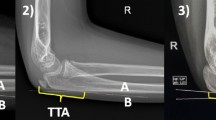Abstract
Purpose
Complex fractures of the olecranon have always been a difficult condition for treatment. Successful reconstruction depends on restoration of the anatomic contributors to stability. The purpose of this study was to define the proximal ulna anatomy in detail with respect to fracture fixation and arthroscopy.
Methods
In 50 normal adult ulnae (26 left, 24 right); posterior olecranon height (POH), olecranon width (OW), trochlear notch width (TW), the distances between the olecranon and the trochlear notch on radial and ulnar sides (RTH, UTH), and proximal ulnar angulations were measured with a ruler and a digital goniometer.
Results
The average POH was 24.6 mm, OW was 23.1 mm, TW was 22.3 mm, RTH was 16.2 mm, and UTH was 15.8 mm. The mean value for proximal ulna torsion angle (PUTA) was found 11.1°. The mean varus angulation was 9.3°. The average articular angle was 27.7° and proximal ulnar dorsal angulation (PUDA) was 8°.
Conclusions
The unique bony architecture of the proximal ulna presents particular difficulties for the implants used in fracture fixation and arthroplasty of the elbow. Knowing the detailed anatomy of the variations of proximal ulna will guide the surgeon to obtain a more reliable length of the olecranon and to offer a safe place for Kirschner wire replacement concerning humero-ulnar joint functionality. In this study, PUTA was also defined. The angle determines the rotation of the proximal ulna and it has a great importance for the movements of the joint. The measured angulations will help the surgeon to design the proper prosthesis for the maintenance of the functions of the elbow joint.







Similar content being viewed by others
References
Bailey CS, MacDermid J, Patterson SD, King GJ (2001) Outcome of plate fixation of olecranon fractures. J Orthop Trauma 15(8):542–548
Candal-Couto JJ, Williams JR, Sanderson PL (2005) Impaired forearm rotation after tension-band-wiring fixation of olecranon fractures. evaluation of the transcortical k-wire technique. J Orthop Trauma 19:480–482
Chalidis BE, Sachinis NC, Samoladas EP, Dimitriou CG, Pournaras JD (2008) Is tension band wiring technique the “gold standard” for the treatment of olecranon fractures? A long term functional outcome study. J orthop surg res 3:9. doi:10.1186/1749-799X-3-9
Cowal LS, Pastor RF (2008) Dimensional variation in the proximal ulna: evaluation of a metric method for sex assessment. Am J Phys Anthropol 135(4):469–478. doi:10.1002/ajpa.20771
Grechenig W, Clement H, Pichler W, Tesch NP, Windisch G (2007) The influence of lateral and anterior angulation of the proximal ulna on the treatment of a monteggia fracture. An anatomical cadaver study. J Bone Joint Surg. doi:10.1302/0301-620x.89b6
Hak DJ, Golladay GJ (2000) Olecranon fractures: treatment options. J Am Acad Orthop Surg 8:266–275
Lavigne G, Baratz M (2004) Fractures of the olecranon. J Am Soc Surg Hand 4(2):94–102. doi:10.1016/j.jassh.2004.02.004
Macko D, Szabo R (1985) Complicationsof tension-band wiring of olecranon fractures. J Bone Joint Surg 67(9):1369–1401
Mulieri PJ, Frankle MA, Mighell MA (2012) Fractures of the Olecranon and Complex Fracture–Dislocations of the Proximal Ulna and Radial Head. In: Stanley D, Trail I (eds) Operative elbow surgery. Elsevier, UK, pp 329–345. doi:10.1016/b978-0-7020-3099-4.00022-9
Newman SD, Mauffrey C, Krikler S (2009) Olecranon fractures. Injury 40(6):575–581. doi:10.1016/j.injury.2008.12.013
Nowinski RJ, Nork SE, Segina DN, Benirschke SK (2000) Comminuted fracture-dislocations of the elbow treated with an AO wrist fusion plate. Clin Orthop Relat Res 378:238–244
Oztuna V, Eskandari MM, Ozturk H, Milcan A, Kuyurtar F (2001) The torsional profile of the proximal humeral articular surface. Acta Orthop Traumatol Turc 35:260–264
Puchwein P, Schildhauer TA, Schöffmann S, Heidari N, Windisch G, Pichler W (2012) Three-dimensional morphometry of the proximal ulna: a comparison to currently used anatomically preshaped ulna plates. J Shoulder Elbow Surg 21:1018–1023
Ring D, Jupiter JB, Sanders RW, Mast J, Simpson NS (1997) Transolecranon fracture-dislocation of the elbow. J Orthop Trauma 11(8):545–550
Rouleau DM, Faber KJ, Athwal GS (2010) The proximal ulna dorsal angulation: a radiographic study. J shoulder elbow surg 19(1):26–30. doi:10.1016/j.jse.2009.07.005
Rouleau DM, Canet F, Chapleau J, Petit Y, Sandman E, Faber KJ, Athwal GS (2012) The influence of proximal ulnar morphology on elbow range of motion. J Shoulder Elbow Surg 21:384–388. doi:10.1016/j.jse.2011.10.008
Sahajpal D, Wright TW (2009) Proximal ulna fractures. J hand surg 34(2):357–362. doi:10.1016/j.jhsa.2008.12.022
Standring S (2008) Gray’s anatomy: the anatomical basis of clinical practice, 40th edn. Churchill Livingstone Elsevier, Spain
Totlis T, Anastasopoulos N, Apostolidos S, Paraskevas G, Terzidis I, Natsis K (2014) Proximal ulna morphometry: which are the “true” anatomical preshaped olecranon plates? Surg Radiol Anat. doi:10.1007/s00276-014-1287-5
Wadia F, Kamineni S, Dhotare S, Amis A (2007) Radiographic measurements of normal elbows: clinical relevance to olecranon fractures. Clin Anat 20(4):407–410. doi:10.1002/ca.20431
Wang AA, Mara M, Hutchinson DT (2003) The proximal ulna: an anatomic study with relevance to olecranon osteotomy and fracture fixation. J Shoulder Elbow Surg 12(3):293–296. doi:10.1016/s1058-2746(02)86803-3
Windisch G, Clement H, Grechenig W, Tesch NP, Pichler W (2007) The anatomy of the proximal ulna. J shoulder elbow surg 16(5):661–666. doi:10.1016/j.jse.2006.12.008
Acknowledgments
A partial grant from Turkish Academy of Sciences was utilized for the analysis software used in the study.
Conflict of interest
The authors declare that they have no conflict of interest.
Author information
Authors and Affiliations
Corresponding author
Rights and permissions
About this article
Cite this article
Beşer, C.G., Demiryürek, D., Özsoy, H. et al. Redefining the proximal ulna anatomy. Surg Radiol Anat 36, 1023–1031 (2014). https://doi.org/10.1007/s00276-014-1340-4
Received:
Accepted:
Published:
Issue Date:
DOI: https://doi.org/10.1007/s00276-014-1340-4




